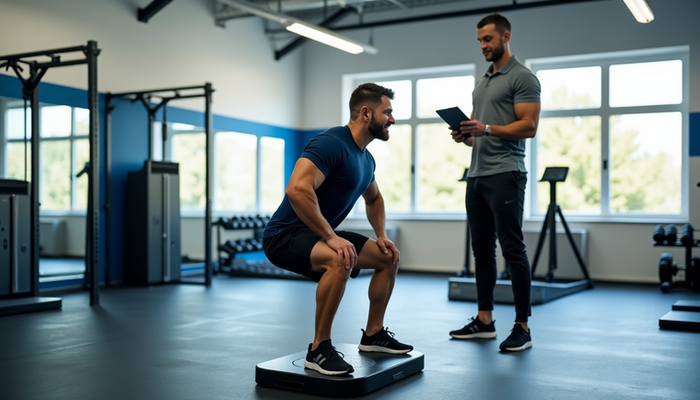
A sports leader's skills can make or break a team's success. Research proves that effective leadership substantially affects team performance, athlete satisfaction and team dynamics.
Leadership excellence in sports demands more than technical expertise. Leaders who coach NCAA Division I athletes or local sports teams must become skilled at key qualities like accountability, emotional intelligence and strategic decision-making. These qualities are vital to success. The Supervisory Behavioral Continuum outlines ten specific behaviors that are the foundations of effective coaching, including listening, encouraging and problem-solving.
Developing strong leadership skills takes time and dedication. We created this piece to help you boost your leadership capabilities and create lasting positive effects on your team's performance.
Outstanding sports leaders stand out from average ones because they possess certain vital qualities. Research shows that the best leaders excel in three basic areas that shape their team's success.
Emotional intelligence in sports leadership starts with self-awareness [1]. Leaders who can read and control their emotions build stronger connections with their teams. They also make better choices under pressure. Studies show that coaches with high emotional intelligence are better at handling stressful situations and resolving conflicts [1].
A leader's self-awareness shapes how they spot emotional responses and grasp their influence on behavior and choices [1]. Sports leaders who practice mindfulness and emotional control excel at handling different personalities. This approach helps create an inclusive and supportive team environment [2].
Between 65% and 93% of a message's meaning comes from voice tone and body language, according to communication experts [3]. The best sports leaders know how to use both verbal and non-verbal signals to share their expectations, goals, and standards with athletes.
Sports leadership communication needs six basic elements: it should be clear, concise, correct, complete, courteous, and constructive [4]. Leaders who excel at communication build environments where open dialog thrives. This helps team members understand their roles and make quick decisions [5].
The success of performance sports relies heavily on choices made by qualified and experienced staff [6]. Sports leaders should make good decisions in unstable, uncertain, complex, and ambiguous situations. Research shows that decision-making gets better through three specific approaches:
Building engaging professional cultures that welcome different views
Using debiasing training to avoid common thinking traps
Setting up evaluation methods with immediate feedback [6]
Expert sports leadership requires knowing the difference between regular challenges and unusual ones [6]. Sports leaders can boost their decision-making skills under pressure through focused training and well-designed processes.
Leadership development starts when you know where you stand. Sports leaders need to assess their current approach to find areas where they can grow and improve [7].
You need a systematic way to understand your leadership approach. Sports leaders typically show three different styles:
Autocratic Leadership: Structured decision-making and clear directives
Democratic Leadership: Collaborative approach with team input
Laissez-Faire Leadership: Relaxed style that promotes autonomy [8]
Leadership assessment tools give you a clear picture of your strengths and areas where you can grow [9]. These evaluations help you identify specific skills like communication patterns, decision-making processes, and ways to motivate your team.
Your leadership style should line up with your team's experience level, cultural backgrounds, and individual needs [7]. Organizations lose 7% of their total annual sales when they delay leadership development [10]. This shows why early assessment and adaptation matter.
Once you understand your leadership style, setting clear development goals is a vital next step. Goals work best when they are specific, measurable, and match what your organization needs [10].
A detailed action plan helps you track progress and stay accountable. Research shows people feel most motivated when they see progress in work that matters [11]. Breaking bigger goals into smaller, manageable steps makes shared growth and achievement possible.
Regular feedback plays a key role in leadership development. Studies show job candidates value learning and growth opportunities more than most other job aspects [11]. Sports leaders can improve their effectiveness and adapt to team changes through continuous assessment and goal adjustment.
Communication is the life-blood of sports leadership that works. Research shows athletes can understand their coaches' body language 4.5 times faster than verbal communication [12].
Active listening needs complete attention to both spoken words and unspoken messages. We focused on six core components:
Give undivided attention without interruption
Hold back judgment during conversations
Reflect and prove athletes' views right
Clear up ambiguous points
Sum up key themes
Share appropriate feedback
Active listening creates a space where athletes feel valued and understood. Studies show between 65% and 93% of message meaning comes from tone of voice and non-verbal behaviors [13].
Good feedback looks ahead at improvement instead of dwelling on past mistakes. The feedback sandwich technique works well, especially when you have positive observations first, followed by areas to improve, and end with encouraging conclusions [12].
Feedback can be challenging. Sports leaders should ensure their team members get the guidance they need while feeling appreciated. The process should be a two-way conversation, not just criticism [12].
Difficult conversations need proper planning and execution. Sports leaders should signal their intent and make sure athletes are ready to receive feedback [12]. Research highlights timing as a vital factor - athletes might not be ready for feedback right after intense situations [12].
Non-verbal communication has several critical elements that affect leadership effectiveness. Studies show more than 65% of communication happens through non-verbal elements [14]. Sports leaders should focus on:
Physical appearance and presence set first impressions, while kinesics (body movements) send subtle messages about attention and involvement. Voice tone and speech speed substantially influence how athletes receive and interpret messages [14].
Sports leaders who excel at non-verbal communication build stronger connections with their athletes. Research confirms athletes respond more quickly to their coaches' body language than any other form of communication [15].
A sports leader's most basic skill is creating a positive team environment. Research shows that 70% of team communication happens through non-verbal elements [16]. This makes the environment vital to team success.
Team success is built on trust that comes from consistent actions and clear expectations. Sports leaders who take responsibility and stay accountable create an environment where athletes feel safe to take calculated risks [17].
A sports leader needs four elements to build trust:
Showing expertise in sport-specific techniques
Keeping communication channels open
Caring about athlete development
Making roles and responsibilities clear
Coaches who run daily team check-ins and keep an open dialog see better team unity [18]. Successful sports leaders let athletes give anonymous feedback. This creates honest communication without judgment [19].
Beyond building trust, knowing how to resolve conflicts is another vital sports leadership skill. Research shows that well-managed conflict can make team relationships stronger and boost performance [1].
Sports leaders need specific strategies to handle conflicts well. Coaches should tackle conflicts right away to stop small issues from becoming big problems [20].
Sports leaders should follow four basic principles when handling conflicts:
Listen actively to understand everyone's viewpoint
Use "I" statements to avoid defensive reactions
Keep non-verbal communication consistent
Stay away from lecturing or making threats
Research shows that coaches with a democratic leadership style create positive team environments more often [7]. This approach values different opinions and helps athletes feel comfortable sharing their concerns.
Sports leaders should set clear expectations early in the season to resolve conflicts better [20]. This helps prevent common team disputes and creates a foundation to handle disagreements constructively.
Sports leaders need to assess their progress as they develop their skills. Research shows that Key Performance Indicators (KPIs) link data and processes with performance outcomes objectively [21].
We focused on quantifiable measures to assess success in sports leadership. Research reveals that KPIs help assess offensive success, team performance, and individual player development [22]. Sports leaders should track several significant indicators:
Team performance metrics (win rates, success percentages)
Individual athlete development progress
Leadership behavior changes
Team engagement levels
Communication effectiveness rates
Studies show that practitioners prefer simple, event-based KPIs that give clear insights into performance [22]. All the same, research stresses the need to implement both formative and summative evaluations to measure leadership effectiveness [23].
Sports leaders understand that detailed feedback needs multiple approaches. Research shows that self-reported changes in leadership behaviors are the most assessed coaching outcome [24]. Team leaders can collect effective feedback through three key strategies:
Individual feedback forms the foundation and allows specific improvement areas. Small group feedback sessions help team members share experiences and create collective insights [25]. Studies show that face-to-face interviews explore behavioral changes deeply, while telephone interviews provide affordable detailed information [26].
Research expresses that practitioners who implement regular feedback systems see improved team cohesion and performance [27]. Sports leaders should set clear expectations for feedback sessions and create safe spaces where team members can share honest opinions comfortably [27].
Research shows that leadership coaching creates an evolving dynamic between the coach and team [23]. Sports leaders must adjust their approach after collecting feedback and analyzing KPIs.
Studies emphasize that successful sports leaders adapt their approach based on situation, objectives, and participant needs rather than stick to one style [28]. Without doubt, this flexibility in leadership styles maximizes participant engagement and achievement [28].
Research indicates that evaluation needs both descriptive and judgmental information to make decisions about training efforts [23]. Great sports leaders review their KPIs and feedback data regularly to identify areas for improvement [21].
Ongoing process trackers (OPTs) measure the execution of behaviors that create successful performance environments effectively [21]. These trackers help sports leaders focus on implementing conditions that encourage team success while adapting their approach based on concrete data and feedback [21].
Sports leadership needs dedication, self-reflection, and continuous growth. Leaders who excel in emotional intelligence, clear communication, and strategic decision-making create lasting positive effects on their teams. Research confirms this.
A sports leader's success comes from understanding their current approach and working to improve it. You can adapt your leadership style to meet your team's evolving needs by regularly assessing key performance indicators and collecting team feedback.
Trust building, effective conflict management, and open communication channels are the foundations of successful sports leadership. Leaders who commit to these principles and track their progress create environments where athletes and teams thrive.
The path to leadership excellence needs patience and persistence. You should begin with small changes, measure their effects, and adjust your approach based on data and team feedback. These essential skills will lead to better team dynamics, increased performance, and stronger connections with your athletes.
[1] - https://www.athleteassessments.com/coachs-guide-managing-conflict-in-sport/
[2] - https://www.studysmarter.co.uk/explanations/sports-science/sport-business/sports-leadership/
[3] - https://us.humankinetics.com/blogs/excerpt/good-communication-skills-are-key-to-successful-coaching?srsltid=AfmBOoqE6ScGwJlLG9v2ZCAf-AnvZVX3hBe1EHyYpvOsILN891leu0rQ
[4] - https://bjsm.bmj.com/content/44/Suppl_1/i49.3
[5] - https://onlinesportmanagement.ku.edu/community/leadership-and-management-in-sports
[6] - https://sportsmedicine-open.springeropen.com/articles/10.1186/s40798-023-00629-w
[7] - https://online.jwu.edu/blog/leadership-styles-in-sports-how-different-approaches-shape-team-dynamics/
[8] - https://www.leadershipandsport.com/leadership-styles-in-sports-coaching/
[9] - https://coachfoundation.com/blog/leadership-assessment-tools/
[10] - https://arbinger.com/blog/leadership-effectiveness-how-to-set-leadership-development-goals/
[11] - https://www.athleteassessments.com/sport-management-leadership-coaching/
[12] - https://truesport.org/respect-accountability/give-appreciative-feedback/
[13] - https://us.humankinetics.com/blogs/excerpt/good-communication-skills-are-key-to-successful-coaching?srsltid=AfmBOopFB1cszuAbmBfVI9MjD8NRu2IvPBvshh1HhGn_y46KblsUevDV
[14] - https://opensportssciencesjournal.com/VOLUME/16/ELOCATOR/e1875399X2304100/FULLTEXT/
[15] - https://sirc.ca/articles/non-verbal-communication-in-sport/
[16] - https://www.movesports.com/en/field-stories/sports/team-dynamics-and-success-building-cohesion-in-sports-teams
[17] - https://education.msu.edu/sport-coaching-leadership/uncategorized/building-trust-within-your-team/
[18] - https://uscenterforsafesport.org/build-team-trust/
[19] - https://truesport.org/teamwork/5-ways-foster-positive-team-culture/
[20] - https://www.innerdrive.co.uk/blog/team-conflict-management/
[21] - https://www.researchgate.net/publication/375090484_Selection_of_Key_Performance_Indicators_for_Your_Sport_and_Program_Proposing_a_Complementary_Process-_Driven_Approach
[22] - https://pmc.ncbi.nlm.nih.gov/articles/PMC7919358/
[23] - https://www.sciencedirect.com/science/article/abs/pii/S1048984310000895
[24] - https://www.researchgate.net/publication/228884725_Evaluating_leadership_coaching_A_review_and_integrated_framework
[25] - https://coachbetter.tv/3-ways-to-collect-feedback-on-your-coaching-practice/
[26] - https://www.employment-studies.co.uk/system/files/resources/files/430.pdf
[27] - https://blog.blueoceanbrain.com/blog/how-to-run-a-team-feedback-session
[28] - https://studyrocket.co.uk/revision/level-1-sport-btec/leading-an-activity-session/exploring-different-leadership-styles-in-sport-contexts
